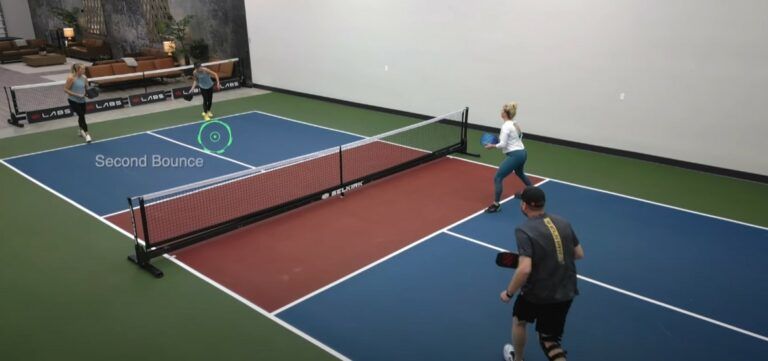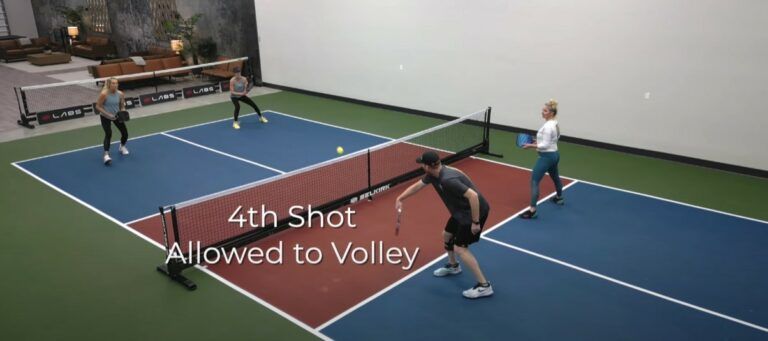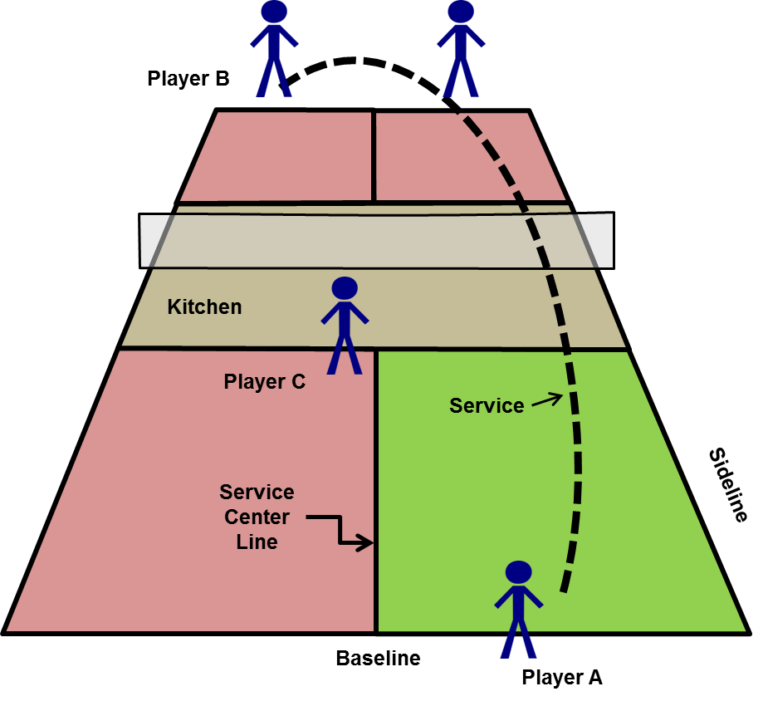Pickleball Double Bounce Rule: Understanding the basics
Before we dive into the technicalities, it's essential to frame the two-bounce rule within the broader context of pickleball. Imagine entering a well-choreographed dance where each player must adhere to specific steps to create harmony. The rule provides this structure, detailing how play should commence after a serve, transformational for beginners and vital for experts.
What is the two-bounce rule?
The two-bounce rule, as defined by the official pickleball guidelines, requires that after the ball is served, it must bounce once on the receiving side before being returned. Subsequently, the serving team must also allow the ball to bounce once on their side before they can hit it back. This sequence creates a dynamic interaction where players must remain attentive and agile, ensuring they respond thoughtfully rather than solely relying on reaction speed.

To visualize this:
- The server initiates play with a well-executed serve.
- The receiving team allows the ball to bounce once, setting the stage for their return.
- The serving team then lets the returned ball bounce once before choosing to volley or play groundstrokes.
This rule not only governs the start of points but also profoundly affects players’ styles of play by emphasizing strategic positioning and shot selection rather than unbridled power.
Why does the two-bounce rule exist?
The establishment of the two-bounce rule serves multiple purposes. Firstly, it aims to create a level playing field, enhancing the sport's accessibility for players of all ages and skill levels. A quick analysis of gameplay dynamics tells us that the serving team can unintentionally dominate if players rush to the net immediately after serving. By mandating a bounce on both sides, the rule mitigates that potential imbalance.
Moreover, this rule encourages longer rallies, fostering a more engaging game experience. In fact, studies have shown that games adhering to the two-bounce rule often have increased rallies by up to 30%, leading to better-paced matches filled with tactical exchanges. This gentle pacing cultivates an environment where strategy reigns supreme, promoting teamwork and communication essential ingredients for competitive play.
Avoiding common mistakes
Though the two-bounce rule may seem straightforward, beginners often stumble through common pitfalls that can lead to lost points and frustration. Identifying these mistakes is crucial for improving your game.

Volleying before the bounce
One of the most prevalent errors among beginners is the tendency to volley the ball before allowing it to bounce. This mistake not only results in a fault but disrupts the game’s flow. Have you ever tried rushing a chess move only to realize you could have strategized better? The same principle applies here. To avoid this, players must cultivate patience, positioning themselves to wait for the ball to settle before they make a move.
Practical advice includes an active focus on footwork stay back near the baseline during the serve and allow the ball’s first bounce to dictate your next move. This practice helps ensure that you are aligned with the rule and equipped for a powerful return.
Rushing the net (serving team)
Another common mistake is the serving team rushing towards the net too quickly. Think of it as a football quarterback; charging forward without assessing your defense can lead to unexpected plays. When serving, it’s essential for players to position themselves behind the baseline, maintaining a balanced stance that allows for optimal reaction to the received serve. This approach not only strengthens your position but permits a strategic cut-off for the opponent’s shot.
Encouragement to stay vigilant and focused on the bounce can significantly elevate performance levels and the overall vibe on the court.
Mastering player positioning
Player positioning plays a critical role in executing the two-bounce rule effectively. Navigating court space becomes a strategic game in itself.

Receiving team positioning
The receiving team should focus on positioning themselves near the baseline. This placement is vital for handling deep serves that might threaten their playing space. Remaining patient and grounded will help avoid the temptation to volley before the bounce. Proper positioning gives players the time needed to respond thoughtfully and sets up a disciplined retaliation.
Serving team positioning
Likewise, players on the serving team should aim to start behind the baseline. This understanding fosters a stronger foundation for watching the ball's path and ensuring the second bounce occurs. Additionally, positioning allows a proactive response to the opponent’s return. Encourage this dialed-in approach, and players will notice improved gameplay dynamics as reactions become second nature.
Doubles positioning
In the case of doubles play, positioning becomes even more complex and intriguing. The non-serving partner should ideally start at the non-volley zone line, ready to engage with strategic plays while the primary server focuses on delivering a powerful serve. This formation emphasizes the importance of communication, ensuring clarity between partners to avoid confusion and unnecessary faults.
Advanced concepts and strategies
Once you’ve mastered the basics of the two-bounce rule, exploring advanced concepts can further enhance your pickleball game.
The first server exception
In the context of doubles, understanding the first server exception rule is essential. This rule states that for the initial serve of each game, both members of the serving team take their turn serving until they lose a point. This nuanced aspect of serving dynamics can shift the strategy of play, giving the first server an opportunity to find their rhythm before passing the baton to their teammate.
Strategic advantages of the two-bounce rule
Beyond fostering fairness among players, the two-bounce rule opens avenues for strategic advantages. Players can leverage the sequence of bounces to gain control over the rally:
- Setting up dink rallies: By carefully allowing the ball to bounce, players can initiate soft exchanges, drawing opponents in for precise positioning opportunities.
- Forcing weaker returns: Strategically using deep serves can pressure opponents into making less aggressive returns, allowing players to seize control of the point.
- Controlling game pace: The two-bounce allows players to dictate the tempo slowing down with tactical pauses or speeding up aggressive volleys as the situation dictates.
These strategies not only enrich gameplay but also lead to more captivating experiences for both players and spectators.
Debunking common myths
There are various misconceptions surrounding the two-bounce rule that players often carry into play. For instance, some players falsely believe that the second bounce may not land in the kitchen (non-volley zone), but it actually can. Understanding these clarifications helps reduce confusion and enhances adherence to rules.
A popular query includes what happens if the ball hits the net before bouncing on the opponent's side. Players are encouraged to consult the official rulebook for clarification, ensuring they are well-versed in the regulations governing play.
Practice and improvement
Mastering the two-bounce rule not only takes theoretical knowledge but requires practical application through consistent practice and drills.
Drills for mastering the two-bounce rule
To internalize the two-bounce sequence, players can engage in specific drills designed to enhance their skills:
- Two-bounce rally: Players focus on engaging in rallies, ensuring that bounces occur before any volleys. This fosters timing awareness and strengthens this critical element of gameplay.
- Serve and return practice: Dedicated sessions should be established to practice serving and returning, emphasizing that players refrain from hitting until after the bounce.
- Doubles positioning drills: Partners can work on communication skills and positioning, creating a seamless barrier of synergy that enhances their overall performance.
These drills not only build fundamental skills surrounding the two-bounce rule but also facilitate overall growth and confidence on the court.
Why was it renamed?
In 2018, the shift from “double bounce” to “two-bounce” occurred to engender clearer communication among players and reduce confusion surrounding the terminology. The clarity of “two-bounce” reinforces the essence of the rule while avoiding any overlap with the concept of the double bounce fault, ensuring players can focus solely on gameplay.
Conclusion
Embracing the two-bounce rule opens the door to a more strategic, engaging, and inclusive pickleball experience. As players navigate the intricacies of serving, positioning, and responding to bounces, a deeper appreciation for the sport unfolds. By practicing the steps, studying advanced strategies, and avoiding common pitfalls, you’ll not only improve your game but also the enjoyment of the pickleball community. So step onto the court, embrace the challenge, and have fun honing your skills while weaving through the rules that shape the exciting game of pickleball!










